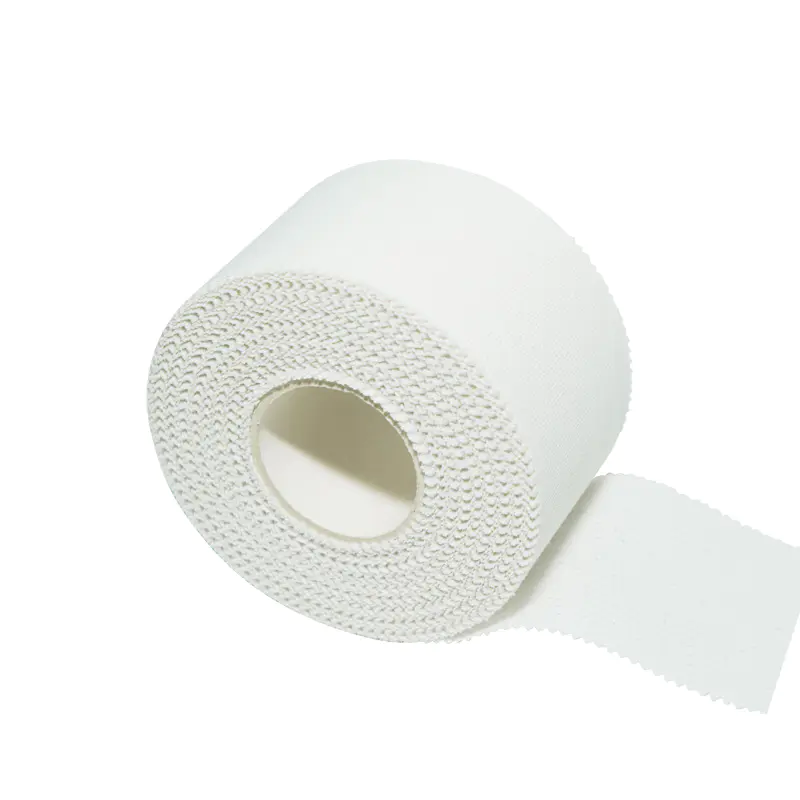The terms "sports tape" and "athletic tape" are often used synonymously to describe tapes applied to the body to prevent injuries, support existing injuries, or enhance performance during physical activity. The key differences lie not in the general terms themselves, but in the specific types of tape available and their intended uses.
While the names might be used interchangeably, here are the main categories and their distinct characteristics:
This is what most people typically picture when they hear "athletic tape."
Characteristics: Made from a strong, non-stretch cotton or synthetic fabric with a zinc oxide adhesive. It's designed to be completely inflexible.
Primary Purpose: Immobilization and Restriction of Movement. Rigid tape provides maximum support and limits the range of motion of joints or muscles.
Common Applications:
Ankle Sprains: Often used to create a "stirrup" or "heel lock" to prevent inversion or eversion of the ankle, crucial for preventing re-injury.
Wrist Support: Taping wrists can stabilize the joint during heavy lifting or impact sports.
Finger and Thumb Support: Buddy taping fingers or taping thumbs helps support ligaments and prevent hyperextension.
Joint Stability: Providing external support to hypermobile or unstable joints.
Key Benefit: High level of support and protection against excessive movement.
Considerations: Can restrict blood flow if applied too tightly. Requires skill to apply correctly to avoid skin irritation or further injury.
Often referred to as "kinesio tape," this is a more modern and distinct type of athletic tape.
Characteristics: Highly elastic, breathable, and water-resistant, usually made from a cotton-synthetic blend with an acrylic adhesive. It stretches up to 140% of its original length, mimicking the elasticity of human skin.
Primary Purpose: Support Without Restriction, Pain Relief, and Facilitation of Natural Healing. Kinesiology tape works by lifting the skin microscopically, which can improve circulation, reduce pressure on pain receptors, and facilitate lymphatic drainage.
Common Applications:
Muscle Support: Can be applied to facilitate or inhibit muscle action, depending on the direction and tension of application.
Pain Reduction: Helps alleviate pain from various musculoskeletal conditions like shin splints, runner's knee, or shoulder pain.
Swelling Reduction: By creating convolutions in the skin, it can aid in reducing edema and bruising.
Improved Proprioception: Provides sensory input that can enhance body awareness and movement patterns.
Key Benefit: Allows full range of motion while providing therapeutic benefits. Can be worn for several days.
Considerations: Requires specific knowledge and training for effective application. Not designed for complete immobilization.
This is not a tape in itself but an essential companion product.
Characteristics: A thin, foam-like material, usually non-adhesive, applied directly to the skin before rigid athletic tape.
Primary Purpose: Skin Protection. Creates a barrier between the skin and adhesive tape to prevent skin irritation, blisters, and hair pulling during tape removal.
Common Applications: Used universally under rigid athletic tape.
Key Benefit: Enhances comfort and reduces the risk of skin damage.

While not always strictly categorized as "tape," these are frequently used in sports first aid.
Characteristics: A non-adhesive elastic bandage that sticks to itself rather than to skin or hair.
Primary Purpose: Compression and Light Support. Ideal for securing dressings, providing light compression for minor sprains, or holding cold packs in place.
Common Applications:
Compression for Swelling: Applied to reduce swelling in minor sprains or strains.
Securing Pads/Dressings: Holds protective padding or wound dressings firmly.
Light Joint Support: Offers very minimal support compared to rigid tape but can provide some stability.
Key Benefit: Easy to apply and remove, does not require adhesive directly on the skin.
Considerations: Provides significantly less support than rigid athletic tape.
The "difference" between "sports tape" and "athletic tape" really boils down to the specific properties and intended use of the product. When selecting tape, consider:
The type of injury or prevention needed: Do you need rigid immobilization, flexible support, or pain relief?
The body part: Different tapes are better suited for different joints and muscles.
Your activity level: How much range of motion do you need to maintain?
Skin sensitivity: Some individuals may react to certain adhesives.
In summary, while "sports tape" and "athletic tape" are largely interchangeable terms, understanding the distinct functions of rigid athletic tape, kinesiology tape, and supplementary products like underwrap is crucial for effective injury prevention, rehabilitation, and performance enhancement in sports.







